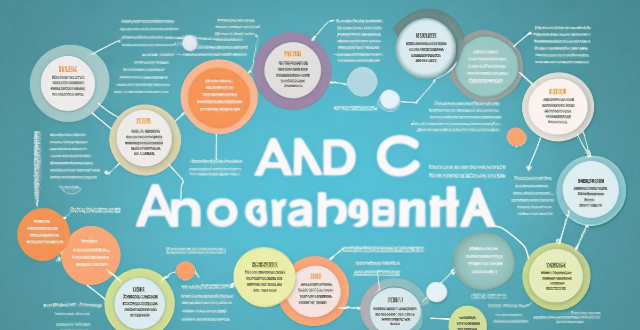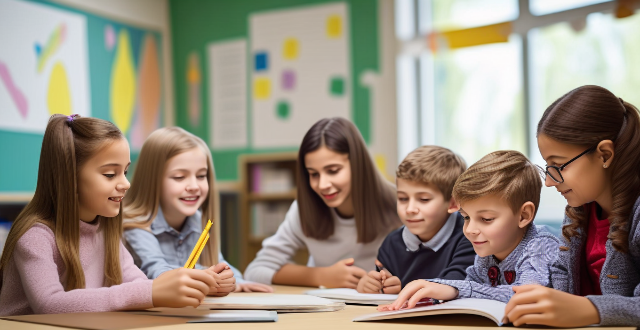Education Help

How can education help combat climate change ?
Education is a powerful tool in the fight against climate change by fostering awareness, promoting sustainable practices, stimulating innovation, and shaping policy. It empowers individuals to make informed decisions and advocate for environmental protection through comprehensive science education, applied learning experiences, interdisciplinary research, and civic engagement. By integrating sustainability into curricula and encouraging global perspectives, education prepares future generations to tackle the complex challenges of climate change effectively.

What are the benefits of preschool education ?
Preschool education is crucial for children's future academic success and overall development, offering benefits in social development, cognitive growth, early literacy and math skills, fine and gross motor skills, self-help abilities, school readiness, and parental involvement. It helps children develop interpersonal skills, emotional intelligence, language skills, problem-solving abilities, reading readiness, math concepts, hand-eye coordination, physical fitness, independence, life skills, routine adaptation, classroom etiquette, family partnerships, and parent education. Preschool prepares children for elementary school by nurturing their social, emotional, cognitive, physical, and self-help skills in a stimulating and supportive environment.

How can education and awareness programs help in promoting resource-efficient utilization ?
Education and awareness programs are crucial for promoting resource-efficient utilization. These programs can help individuals make informed decisions about their consumption habits and encourage them to adopt more sustainable practices. To maximize the impact of education and awareness programs, it is important to target different audiences, use multiple channels for dissemination, provide practical tips and strategies, and foster a sense of community and collective action towards sustainability goals. By doing so, these programs can contribute significantly to resource efficiency and promote sustainable development.

What are the benefits of sports education for children's development ?
Sports education offers a wide range of benefits for children's development, including improved physical fitness, motor skills, cognitive abilities, stress reduction, social skills, self-esteem, emotional regulation, and resilience. These skills are essential for building strong relationships and succeeding in both personal and professional life. By encouraging children to participate in sports activities, parents and educators can help them lead healthier lives and develop life skills that will serve them well into adulthood.

How can multicultural education help reduce racial and ethnic discrimination ?
Multicultural education is crucial in combating racial and ethnic discrimination. It fosters cultural awareness, intercultural competence, challenges biases, promotes social justice, builds inclusive communities, and prepares global citizens. By doing so, it helps reduce discrimination and creates a more equitable and harmonious society.

In what ways can sports education improve mental health and well-being ?
Sports education plays a crucial role in enhancing mental health and overall well-being by offering numerous benefits that contribute to the development of a healthy mind and body. It helps reduce stress, improve self-esteem, promote better sleep, provide opportunities for social interaction, teach goal setting, time management, resilience and perseverance, and develop mindfulness and focus. By promoting physical activity, social interaction, goal setting, time management, resilience, and mindfulness, sports education can help individuals develop the skills they need to lead healthy, fulfilling lives.

How does sports education promote teamwork and social skills among students ?
Sports education promotes teamwork and social skills among students by teaching cooperation, communication, trust, respect, discipline, leadership, resilience, empathy, and self-esteem. These skills help students succeed in sports and prepare them for future challenges in life.

What are some resources available to help me with education budget planning ?
Education budget planning is crucial for managing finances and ensuring sufficient funds for educational expenses. Various resources are available to assist in this process, including government websites, college websites, scholarship search engines, financial aid consultants, online tools, and personal finance apps. These resources provide information on financial aid, scholarships, grants, loans, tuition fees, payment plans, and personalized guidance for securing funding. By utilizing these resources, individuals can effectively plan their education budget and achieve their academic goals.

How can sports education help prevent injuries and promote safe exercise habits ?
Sports education is crucial for preventing injuries and promoting safe exercise habits. It emphasizes proper warm-up and cool-down exercises, correct technique and form, safety equipment and gear, stretching and flexibility, hydration and nutrition, and rest and recovery. By providing athletes with the necessary knowledge, skills, and attitudes, sports education helps them avoid common mistakes that lead to injuries and develop healthy exercise routines.

How can we ensure that climate education is accessible to all students, regardless of their socioeconomic background ?
Education about climate change is crucial for the future of our planet, and it's essential that this knowledge is accessible to all students, regardless of their socioeconomic background. Here are some ways we can ensure that: 1. Public Funding for Education: By increasing public funding for education, we can provide more resources to schools that serve low-income communities. This includes providing textbooks, technology, and other materials necessary for teaching about climate change. 2. Digital Learning Platforms: Digital learning platforms can be used to deliver climate education to students who may not have access to traditional classroom settings. These platforms can provide interactive lessons, videos, and simulations that can help students understand complex concepts related to climate change. 3. Community Outreach Programs: Community outreach programs can help bridge the gap between schools and underserved communities. These programs can offer workshops, field trips, and other activities that focus on climate change education. 4. Inclusive Curriculum Design: Curriculum design should be inclusive of all students, regardless of their socioeconomic background. This means incorporating diverse perspectives and experiences into the curriculum, as well as addressing issues related to social justice and equity. 5. Teacher Training and Support: Teachers play a critical role in delivering climate change education to students. Providing training and support to teachers can help them develop effective strategies for teaching about climate change, especially in diverse classroom settings.

What strategies can teachers use to accommodate students with special education needs in the classroom ?
Strategies for Accommodating Students with Special Education Needs in the Classroom As an educator, it is essential to create an inclusive learning environment that meets the needs of all students, including those with special education needs. In this article, we will explore some effective strategies that teachers can use to accommodate students with special education needs in the classroom. 1\. Differentiated Instruction Differentiated instruction is a teaching approach that tailors instruction to meet individual student needs. This strategy involves modifying curriculum, instruction, and assessment to address diverse learning styles, abilities, and interests. Here are some ways to implement differentiated instruction: * **Varying the complexity of tasks**: Assign tasks of varying difficulty levels based on students' abilities and progress. * **Providing multiple means of representation**: Use visual aids, manipulatives, or technology to help students understand complex concepts. * **Offering choices in assignments**: Allow students to choose from different assignments or projects that align with their interests and strengths. 2\. Collaborative Learning Collaborative learning encourages students to work together to achieve common goals. This approach can benefit students with special education needs by providing opportunities for social interaction and peer support. Some collaborative learning strategies include: * **Group work**: Assign students to groups based on their skills and interests, ensuring each member has a role to play. * **Partner reading**: Have students read aloud with a partner, taking turns summarizing what they have read. * **Peer tutoring**: Match students with stronger academic skills with those who need additional support, allowing them to learn from each other. 3\. Assistive Technology Assistive technology refers to tools and devices designed to help individuals with disabilities perform tasks more easily. Incorporating assistive technology into the classroom can greatly benefit students with special education needs. Some examples of assistive technology include: * **Speech recognition software**: Helps students with physical limitations or dyslexia to dictate their thoughts and ideas. * **Audiobooks**: Provides auditory input for students who struggle with reading comprehension. * **Graphic organizers**: Visual tools that help students organize information and ideas, particularly useful for students with learning disabilities or ADHD. 4\. Clear and Consistent Routines Establishing clear and consistent routines can help reduce anxiety and increase predictability for students with special education needs. Some ways to implement routines include: * **Schedule boards**: Display daily schedules visually to help students understand what to expect throughout the day. * **Transitional cues**: Use verbal or visual cues to signal when it's time to switch activities or move to a different location. * **Predictable lesson structures**: Follow a consistent format for lessons, such as starting with a warm-up activity, followed by direct instruction, independent practice, and wrap-up discussions. 5\. Positive Behavioral Interventions and Supports (PBIS) PBIS is a framework designed to create positive school cultures by promoting appropriate behavior and supporting students in need of behavioral interventions. Some PBIS strategies include: * **Reinforcement systems**: Reward positive behaviors with tangible incentives or praise. * **Social skills training**: Teach students how to interact appropriately with peers and adults through role-playing and modeling. * **Behavior contracts**: Work with individual students to develop agreements outlining expected behaviors and consequences. 6\. Parental Involvement and Communication Maintaining open communication with parents is crucial for supporting students with special education needs. Some ways to involve parents include: * **Regular conferences**: Schedule meetings with parents to discuss their child's progress and address any concerns. * **Homework hotlines**: Provide a phone number or email address where parents can reach out for assistance with homework assignments. * **Family engagement activities**: Plan events that allow families to participate in school activities, fostering partnerships between home and school.

How will these education policy updates impact the future of education in our society ?
Education policy updates may increase access to education, emphasize STEM education, and improve student outcomes.

How can education help in raising awareness about the climate emergency ?
Education is vital for raising awareness about climate change, empowering individuals with knowledge, and fostering a culture of sustainability and action. Integrating climate change education into curriculums and promoting interdisciplinary learning can influence perception through knowledge dissemination, skills development, values formation, and behavior change. Strategies for integrating climate change education include curriculum integration, interactive learning experiences, technology and digital tools, and global perspectives. By prioritizing climate change education, educators, policymakers, and community leaders play a crucial role in shaping a sustainable future.

What role do education systems play in promoting scientific literacy among women ?
Education systems play a crucial role in promoting scientific literacy among women by providing equal access to education, encouraging female teachers, offering extracurricular activities, addressing gender bias, and providing mentorship programs.

How can education and awareness-raising help promote both climate action and the SDGs ?
Education and awareness play a crucial role in promoting climate action and achieving the Sustainable Development Goals (SDGs). By providing individuals with knowledge and understanding of complex environmental issues, we can empower them to make informed decisions and take action towards a more sustainable future. Educational programs can promote environmental literacy, encourage active engagement, and build capacity for innovation that supports both climate action and the achievement of the SDGs. Strategies for promoting climate action and the SDGs through education and awareness include integrating sustainability into curricula, promoting interdisciplinary collaboration, partnering with community organizations, and utilizing technology and social media.

How do these education policy updates align with global education standards ?
Education policy updates align with global education standards in various ways, including curriculum reform, diverse assessment methods, teacher professional development, technology integration, and prioritizing student well-being and inclusivity. These efforts aim to equip students with the necessary skills and knowledge to thrive in a globalized world.

What strategies have been successful in promoting female education in developing countries ?
Promoting female education in developing countries is crucial to socio-economic development. Successful strategies include community engagement, government policies, education system reforms, partnerships, and technology integration. These efforts aim to ensure every girl has the opportunity for quality education.

How can schools best support students with special education needs ?
Schools can best support students with special education needs by implementing individualized education programs, fostering inclusive classrooms, encouraging collaborative teamwork, providing differentiated instruction, offering accessible learning materials, and adopting positive behavioral interventions and supports.

How can we improve climate education in schools ?
Climate education is a crucial aspect of modern education that helps students understand the complexities of our planet's climate system and the impact of human activities on it. Improving climate education in schools requires integrating climate science into various subjects, training educators, engaging students through real-world experiences, and utilizing technology and multimedia tools. By implementing these strategies, we can prepare future generations to tackle the challenges posed by climate change and create a more sustainable future for all.

How do remote education platforms support teachers in delivering quality education ?
Remote education platforms support teachers in delivering quality education by enhancing teaching and learning experiences, improving accessibility and flexibility, and promoting collaboration and communication. These platforms allow for personalized learning, interactive learning, and real-time feedback, enabling students to learn at their own pace and in a way that suits them best. Additionally, remote education platforms enable anywhere, anytime learning, providing diverse learning opportunities and access to high-quality education regardless of location. Finally, these platforms promote collaborative learning and effective communication between teachers and students, creating engaging and effective learning environments.

How can financial education help prevent debt ?
Financial education is crucial in preventing debt by empowering individuals with the knowledge and skills to make informed financial decisions. It covers understanding personal finance, smart borrowing practices, avoiding common pitfalls, and promoting healthy financial habits. By learning budgeting, saving, investing, credit score management, loan shopping, debt consolidation, and avoiding overspending, predatory lending, and credit card traps, individuals can reduce their risk of accumulating debt and enjoy greater financial stability and independence.

What role does diversity play in multicultural education ?
The text discusses the role of diversity in multicultural education, highlighting its benefits such as enhancing cultural awareness, promoting tolerance and acceptance, encouraging open-mindedness and critical thinking, and providing opportunities for personal growth and development. The author emphasizes that embracing diversity in education can contribute to creating a more inclusive and harmonious society.

What are the latest updates in education policy ?
The latest updates in education policy focus on improving the quality of education, increasing accessibility, and preparing students for future challenges. Key areas of reform include remote learning and online education, inclusive education, curriculum reform, teacher professional development, and funding and resource allocation. These changes aim to create a more effective and equitable educational system for all students.

Can preschool education help close the achievement gap ?
Preschool education can help close the achievement gap by providing access to high-quality programs, supporting language development, promoting social and emotional growth, and addressing disparities in early childhood experiences.

How do women's health and education projects address global disparities ?
Women's health and education are crucial for global development, affecting communities' well-being. Women's health projects ensure access to quality healthcare services, including prenatal care and family planning. Education initiatives promote gender equality by increasing girls' enrollment rates and eliminating classroom biases. Economic empowerment projects provide job training and microfinance loans to women entrepreneurs. These efforts create a more equitable world where everyone can thrive.

What are the benefits of using data analytics in education ?
Data analytics has become an increasingly popular tool in education, offering benefits such as improved student performance through personalized learning and early intervention, enhanced teaching practices with curriculum development and professional development, and better decision making with evidence-based decision making and transparency. As technology advances, data analytics is likely to become an even more integral part of the educational landscape.

What training should regular education teachers have to effectively teach students with special education needs ?
Regular education teachers require specialized training to teach students with special education needs (SEN). This should include understanding of SEN, differentiated instruction, collaboration and communication, data collection and analysis, and cultural competency. By equipping teachers with these skills, we can create a more inclusive learning environment for all students.

How can technology be used to enhance learning for students with special education needs ?
Technology can significantly enhance learning for students with special education needs by offering personalized experiences, accessibility features, collaboration tools, data-driven insights, and safety/mental health support.

What changes have been made to the curriculum due to the recent education policy updates ?
The recent education policy updates have brought significant changes to the curriculum, including a focus on core subjects, inclusion of 21st century skills, increased flexibility and choice, integration of technology, assessment reform, and promotion of lifelong learning. These changes aim to enhance the quality of education, improve student outcomes, and prepare students for the challenges of the future.

How can we incorporate climate education into the school curriculum ?
Incorporating climate education into the school curriculum is crucial for preparing future generations to face the challenges posed by climate change. The strategies for integrating climate education include a cross-curricular approach, real-world applications, project-based learning, guest lectures and workshops, technology integration, critical thinking and problem solving, global perspectives, artistic expression, policy and advocacy, and continuous assessment. These approaches engage students across disciplines and prepare them for active participation in addressing one of the most pressing issues of our time.